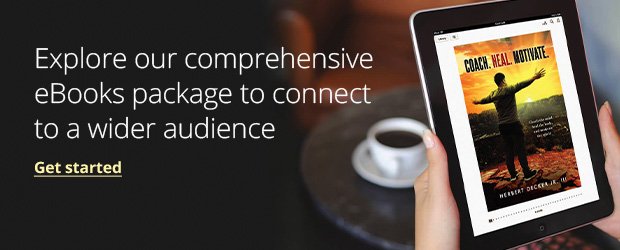By BookBaby author Chris Huff
Estimated reading time: 7 minutes
If your readers have made it to the end of your nonfiction book, you must have done something right! But how do you keep them satisfied and coming back for the next book? One key lies in having a compelling and well-thought-out conclusion. A strong conclusion will drive home your main message, present a tidy summary of your points, and tell the readers specifically what they should be taking away from your thesis and presentation. Here are three suggestions for how to end a nonfiction book to give your readers the best experience possible.
Table of Contents:
• Crafting a strong conclusion
• Encouraging reader action
• Planning the final chapter
• Maintaining the book’s tone and style
• Ready to publish your nonfiction book?
Crafting a strong conclusion
Importance of revisiting main ideas
When learning how to end a nonfiction book, one important way to reinforce your message is by revisiting the main themes you’ve been reiterating throughout. According to research, people tend to forget three out of four things they learn if they have no reinforcement. As you outline your nonfiction book, plan a strong conclusion. Your job in your conclusion is to repeat and reinforce! Don’t just retype your introduction word-for-word, however; using different language to restate your main message and secondary themes. You can also add in details not shared in the introduction that were shared in the chapters between. Hammering away at your main points in your conclusion will ultimately make your book more memorable.
Offering unique insight or takeaways
The repetition of the main themes will lead them to remember your message — but what will that message be? Cassandra Sterling from the Writers’ Cooperative says, “Readers are selfish. They only read something if they think they’ll get something out of it.” Keeping this in mind, it’s crucial to be 110% clear about what you want readers to take away from your book — a new viewpoint on their lives, a plan for change, more insight into a current problem, or something similar. The message should be specific and unique to you and your story or the subject of your book if it’s a more global subject and less personal. Whichever it is, tell readers what you’ve learned and what you want them to have learned in your conclusion. Being concise and clear will go a long way in connecting to them!
Leaving a lasting impact
Ultimately, your impact on readers will be determined by how much you can connect your message to their needs and the problems they need to solve. There’s no hucksterism involved here; slick sales talk and a flashy image might sell one book, but to inspire people to change their lives, transform their ways of thinking, and purchase all the products and books from your sales funnel, your message will need to be authentic, need-focused, and problem-solving. Like any one-on-one sale, it’s not the actual sale that matters ultimately — it’s the relationship. Cultivate trust with your readers by driving your message home in a well-written conclusion which ties the book together in a neat package and delivers it to them in digestible form.
Encouraging reader action
Call to action (CTA)
The call to action (CTA) is the first thing you’d like the reader to do after finishing and putting the book down, and it’s an important part in the process of knowing how to end a nonfiction book. This is not the time for a sales pitch! You have spent the entire book earning the trust of your readers, so now is not the time to blow it with the literary equivalent of clickbait. Assume readers have enough intelligence to form their own opinion about whether to explore your work further. The CTA should be something they can do to improve their own lives and apply what they’ve learned from your book. Highlight actions they can take to integrate the lessons of the book into those lives.
If the topic of your book does lend itself to direct the readers to a landing page on a website, make sure the information provided on the website is new information and not a regurgitation of all the info in the book, and especially in your conclusion. However, make it something that is additive and not crucial, as you don’t want readers thinking: “Why isn’t this in in the book?” Deliver authentic value and you will build a real audience; this means focusing on helping people over the short-term gains of selling something. Remember: it’s all about the relationship!
Resources and further reading
In the 1947 movie Miracle on 34th St., the Macy’s Santa (secretly the real Santa Claus) sent customers to other stores, including the top competitor of Macy’s — Gimbels — to make sure children got exactly what they wanted for Christmas. This is a great example of the spirit of reader encouragement that will help build your audience. Direct them to resources and other books on similar topics that will help them achieve their ultimate goals. Some authors may have a workbook that accompanies their book; promoting this here is fine, but keeping the focus on what can help the reader most is the top priority. You might want to add these resources as a list after the text of the conclusion, or, if you have brief commentary, they can be discussed as part of the concluding chapter or paragraphs.
Personal reflection and author’s note
While adding brand new information is not the right way to end a nonfiction book, it is a good practice to tell new anecdotes or add new personal reflection at the end. If you can tie this into repetition of your main themes and points, so much the better! Additional personal connection will help make the end of your book memorable; people remember stories longer than facts. An author’s note thanking everybody who made your book possible is a nice touch at the end as well, though most likely it’s good to keep this separate from the end text so people who are not interested can skip this section and it doesn’t dilute your message.
Planning the final chapter
Armed with the above knowledge of how to end a nonfiction book, you can now begin planning your final chapter. Summarizing your main points and ideas should be your first goal. In doing this, be as clear as possible so the reader knows what message they are supposed be taking with them (your second goal). End your chapter with a call to action that encourages the reader to incorporate the lessons and/or the message of your nonfiction book into their daily lives. If the book is a memoir, the call to action might take the form of “don’t do what I did!” Keeping the tone of your final chapter bright and active, similar to your introductory chapter, will help convey your message.
Likewise, avoid dry language like “in conclusion” or “to sum up.” Keep your prose lively and interesting, introduce anecdotes, and tie the themes of the book together in a neat package that people can relate to. For most nonfiction books, your basic outline of objectives is something like this: identify a problem, make a promise, and offer a solution or hope. Your final chapter should tell the reader specifically, pointedly, and plainly how you have done this with your book. You’ll want to outline the chapter first before diving in and writing to make sure that you have structured it for the clearest possible read.
Maintaining the book’s tone and style
It’s important that the ending of your book match the beginning in tone and style. This lends an air of authority that readers will relate to and recognize. And (as was said before) if they have read this far, they have become acclimated to your literary voice, so the familiarity of tone will make them more receptive to your end message. The final chapter should tie up any loose ends and connect the disparate parts of your book together in a way that makes sense for readers. Repeat your main ideas and themes enough times for people to remember them, but phrase them differently so as to keep the ending interesting. Spice up the dry facts with personal anecdotes and stories for maximum reader engagement!
Ready to publish your nonfiction book?
By crafting a strong conclusion, encouraging reader action, and planning your final chapter carefully, you will have a strong framework for knowing how to end a nonfiction book. Maintain the style and tone of your entire work for the ending. Focus on clarity and consistency of message, as well blatantly informing your readers what they should be taking away with them after the book is finished. This is not the time to sell to your audience, but rather convince them through your authenticity that you are a trustworthy source of information to help them achieve their goals and/or change their lives. This will open the door for you to grow your audience and together build a lifelong relationship.
BookBaby has numerous resources to assist you with completing and publishing your nonfiction book, including editing, marketing, and self-publishing services. Talk to a Publishing Specialist to get more information on how to start your self-publishing journey.
This BookBaby blog article How to End a Nonfiction Book in 3 Ways appeared first on and was stolen from BookBaby Blog .

